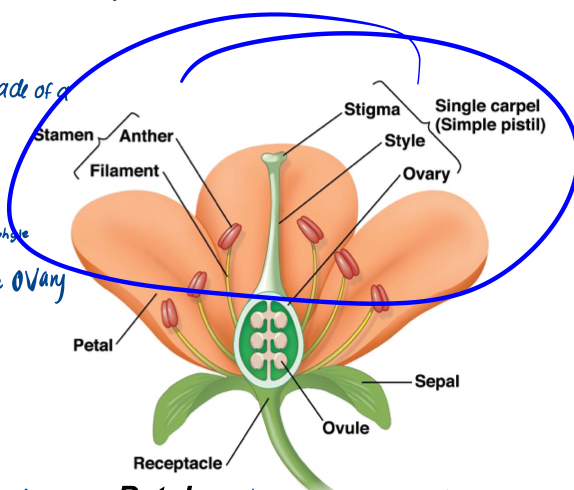study guide 9
Seed Plants Adaptations to Terrestrial Life
Reduced gametophytes
heterospory
ovules
pollen
seeds
Heterosporous vs. Homosporous Plants
Heterosporous Plants:
Produce two types of spores:
Microspores: Develop into male gametophytes.
Megaspores: Develop into female gametophytes.
Homosporous:
Produce one type of spore that develops into a bisexual gametophyte that makes both sperm and eggs.
Ovule, contains, surrounded by?
contain megasporangium and megaspores, transform into seeds after fertilization. megaspores turn into megasporangium, which in turn makes eggs
Integument: from the sporophyte surround and protects the megasporagium
Pollen
contains gametophyte which makes sperm. surrounded by tough sporpollenim
Seeds
made up of an embryo and food supply, packed in a protective coat made of integument
advantage on terresrial: can stay dormant for several years until conditions are favorable for germination
Key Features of Gymnosperms
Groups
cycads (cycadophyta)
Conifers (coniferophyta)
Ginko ( ginkgophyta)
Gnetophyta
Traits
have naked seeds
dominant sporophyte
mostly wind pollinated
Life Cycle of a Pine
describe the steps
Diversity of Gymnosperms
Main groups include:
Cycadophyta (cycads): have flagellated sperm, sago palm
Ginkgophyta (ginkgo)
Gnetophyta (gnetophytes)
Coniferophyta (conifers): often have woody cones and needle-like leaves
Distinguishing Features of Angiosperms
1. flowers
seeds contained in fruits
many rely on animals for pollination and seed dispersal
Parts of a Flower and Their Functions

label and explain the purpose of each parts
Anther: Produces pollen (male gametophytes).
Stigma: Receives pollen during pollination.
Style: Connects the stigma to the ovary.
Ovule: Contains the female gametophyte; develops into a seed post-fertilization.
Sepal: Protects the developing flower bud.
Petal: Attracts pollinators.
Fruits and Their Purpose for Angiosperms
Fruits: thickened ovary wall that surrounds seeds ( mature ovules)
Purpose: protect seed and help in dispersal and source of food for many species and animals
Angiosperm Life Cycle Steps
Describe the steps in the angiosperm life cycle below
Cross-Pollination in Angiosperms
Mechanisms to ensure cross-pollination include:
Diverse flower structures, attract various pollinators.
Temporal separation of male and female flower parts.
Double fertilization: one sperm nucleus fertilized egg ( produces 2n embryo) another sperm nucleus fertilized polar nuclei
Monocot characteristics:
1. one cotyledon
veins usually parrallel
vascular tissue scattered
Eudicot characeritics
two cotyledons
veins usually netlike
pollen grain with three openings
Significance of Gymnosperms and Angiosperms in Human Society
Gymnosperms: Lumber, paper, and medicines are derived from conifers.
Angiosperms: Major source of food, textiles, and other economically important products, significantly influencing agriculture and horticulture.